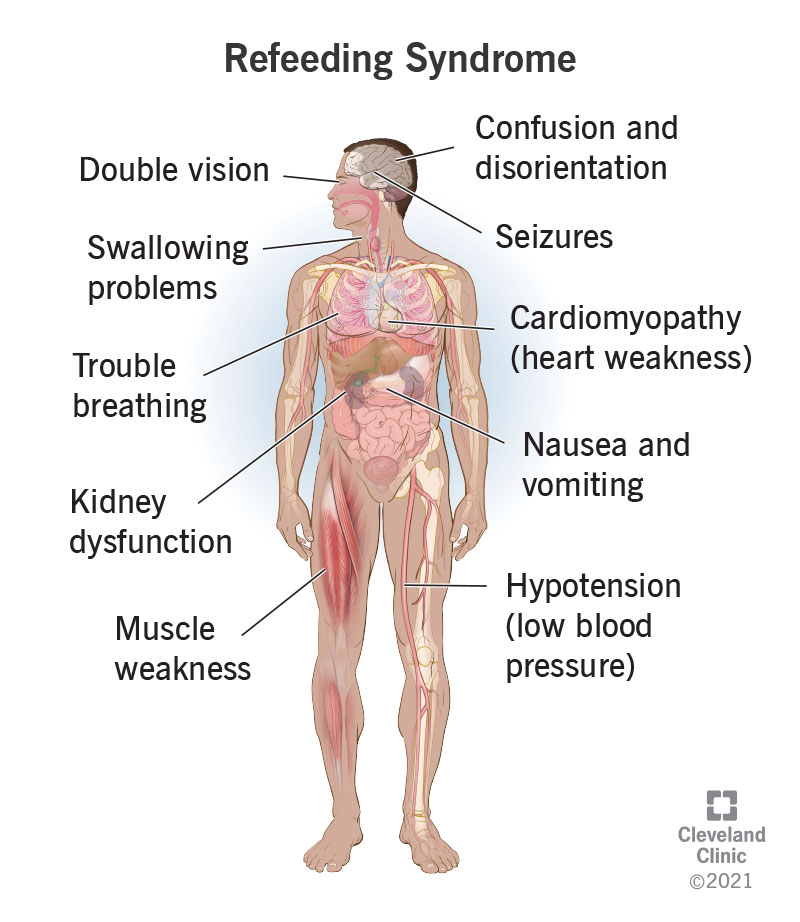Refeeding syndrome can happen when someone who has been malnourished begins feeding again. If food is introduced too quickly, it can cause serious complications. This happens because of the ways our bodies change when they are deprived of nutrients. When we begin refeeding, they have to change back, but they may not have the resources they need.
Advertisement
Cleveland Clinic is a non-profit academic medical center. Advertising on our site helps support our mission. We do not endorse non-Cleveland Clinic products or services. Policy

Refeeding syndrome can happen when somebody who is malnourished begins feeding again. Malnourished means your body is deprived of nutrients. When your body tries to metabolize nutrients again, severe shifts — related to electrolyte deficiencies — can occur in your body’s chemistry. They can cause dangerous complications, affecting your muscles, lungs, heart and brain.
Advertisement
Cleveland Clinic is a non-profit academic medical center. Advertising on our site helps support our mission. We do not endorse non-Cleveland Clinic products or services. Policy
Refeeding syndrome can affect anyone who has begun refeeding after they have been malnourished. If you haven’t been eating enough, you could be malnourished. Certain medical conditions can also cause malnutrition. They can affect your appetite or your ability to absorb nutrients from your food. Some risk factors for malnutrition and refeeding syndrome include:
When your body is starved for nutrients, it makes certain changes to adapt. It changes its metabolism — the way it converts food into energy. Instead of carbohydrates from food, your body metabolizes its own fat and muscle. Metabolism also slows down. Your resting metabolic rate — how much energy you spend while at rest — reduces by as much as 20%.
This type of metabolism takes fewer resources. It doesn't use micronutrients — vitamins, minerals and electrolytes — the way normal metabolism does. But when refeeding begins, so does normal carbohydrate metabolism. Your body reaches deep into its pockets for the micronutrients it needs to get the job done. If your stores are too low, now is when you will feel the effects.
Advertisement
It’s caused by low stores of certain micronutrients in your body. Your stores are low when you have been malnourished. The most common nutrients involved are phosphorus, potassium and magnesium. When you begin refeeding, your cells demand these electrolytes to metabolize the food. This causes a severe shift in your body chemistry.
The electrolytes you have move rapidly from your blood into your cells. But because you don’t have enough, this shift leaves low levels of them in your blood. Low electrolyte levels in your blood are called “deficiencies”. They throw off your body’s chemistry. Electrolyte deficiencies cause the many various complications that can appear in refeeding syndrome.
Refeeding syndrome can manifest in a variety of ways. The most common form is acute phosphate deficiency. But other deficiencies and imbalances may also contribute.
Phosphorus deficiency (hypophosphatemia) is the most common feature of refeeding syndrome. Phosphate deficiency affects cellular processes throughout your body. It may cause:
If you have severe symptoms, phosphate deficiency can cause organ failure, which can be fatal.
Magnesium is an important factor in metabolism. Magnesium deficiency (hypomagnesemia) affects every organ in your body. It may look like:
Mild potassium deficiency (hypokalemia) may not cause symptoms. But more severe deficiency may result in:
Thiamine deficiency is particularly triggered by refeeding with carbohydrates. It can result in severe neurological symptoms, including:
Metabolic changes can affect the balance of sodium and water in your body. In refeeding, this can lead to either fluid overload or dehydration. This can cause:
Reintroducing glucose during refeeding can lead to hyperglycemia (high blood sugar). This can result in:
Advertisement
During refeeding, your healthcare team will check your vital signs. If any abnormalities or symptoms appear, they will investigate by giving you a blood test. This will help them identify the specific imbalances you have and how severe they are.
Before beginning refeeding, your healthcare providers will give you a blood test. They'll measure your electrolyte levels to identify any deficiencies. Then they’ll build the missing micronutrients into your nutritional formula. The idea is to replace your missing micronutrients first. Then, your body will be better prepared to metabolize carbohydrates.
But, electrolyte deficiencies won't always show up in the initial blood test. Because refeeding hasn’t begin yet, your body doesn’t know yet that it will need those electrolytes. The great shift of electrolytes from your blood into your cells hasn’t happened yet. For this reason, sometimes deficiencies don’t show up until after refeeding has begun.
Your healthcare team will continue to watch you for symptoms. They’ll also measure your electrolyte levels daily. Refeeding syndrome usually occurs within the first five days of refeeding. If symptoms appear, your healthcare team will slow down your refeeding. They’ll reduce the carbohydrates in your formula. They may replace your missing nutrients through an IV into your bloodstream.
Advertisement
When your healthcare provider recognizes refeeding syndrome, they can correct it immediately. But the refeeding process takes longer. It may take several weeks to treat the original micronutrient deficiencies.
Complications from refeeding syndrome can lead to death, but usually, they’re less severe. Once your healthcare team corrects the imbalances involved, most symptoms are reversible.
It’s not always possible to avoid the need for refeeding, but you can take certain precautions.
Refeeding syndrome is a complication of treatment for malnourishment. This is already a stressful condition for your body to endure. It may seem counterintuitive, but too much cure too quickly can be harmful. Refeeding is a delicate and complex process. Ideally, it should be medically supervised. During medical refeeding, your healthcare team will monitor you closely. They’ll work to prevent refeeding syndrome and will be prepared to manage it if needed.
Advertisement
Last reviewed on 06/06/2022.
Learn more about the Health Library and our editorial process.